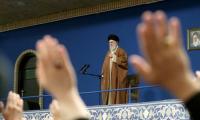Company's administration in Delhi, and assumed control of Shahjahanabad and its immediate outskirts. There is a perception that the Meerut sipahis demonstrated their immaturity in naming a 'doddering old fool' as their leader. And as such, the action of the sipahis is regarded as being futile and meaningless since the Mughal emperor was by this time politically impotent.
The military conflict entered a critical phase in the first week of July when Bakht Khan assumed command of sipahi operations. Bakht Khan, who had been a subedar in the artillery wing of the Bengal army, arrived in Delhi at the head of a large sipahi force from Bareilly on 1 July. He was to emerge as the foremost leader of the rebel administration and military organization. Bakht Khan's initiatives were responsible for widening the scope of the revolt in North India. He had been instrumental in the liberation of Rohilkhand. Here a new regime, with its headquarters at Bareilly, had been installed under Khan Bahadur Khan before Bakht Khan marched to Delhi. The decision to proceed to Delhi itself implied that Bakht Khan had a larger objective in view. He was in touch with rebels in Neemuch, Farrukhabad, Rewari, Mathura, and Bulandshahr; appointed officials for the collection of revenue at Gurgaon, Palwal, and Hodal; and kept a close watch over the Bareilly government. At his behest the emperor sent shuqqasto the rulers of Patiala, Jammu, and Baize Bai of Gwalior commanding them to join the fight against the company. Bakht Khan realized that the British would sooner or later crush the uprising if it remained confined to isolated pockets of resistance. Surprisingly, he did not attempt to establish contact with the formidable Kunwar Singh who was leading the struggle in Bihar.
The main organ of the sipahi regime was the 'court of administration'. In the (undated) original constitution of this 'military and civil management committee', written in Urdu, the English language words were used to name the organ. A facsimile of this remarkable six page document which forms part of the 'Mutiny Papers' in the National Archives of India is reproduced in S.N. Sen's Eighteen Fifty-Seven. The history of the framing of the constitution was discussed at length by Mahdi Husain, who argued that the court of administration was already in existence by the middle of May. All executive, judicial, and revenue authority was vested in the court of administration. It was organized essentially on democratic principles, although formally Bahadur Shah was the head of the government. The court of administration had ten members: six representing the three branches of the army (infantry, cavalry, and artillery), and four civilians. They were elected by majority from among the people who were regarded as 'intelligent, wise, and capable. The members of the court elected a president from among themselves (sadr-e-jalsa), and a vice-president (naibsadr-e-jalsa). The president had two votes. The court administration held daily sessions. Bahadur Shah had the right to be present at all sessions, but the court of administration took all decisions. The emperor's approval would then be sought, and his seal would be put on documents recording these decisions.
We can see in the constitution of the court of administration the vision of a new state in its embryonic form. It is not easy to speculate as to what the shape of the state would have been had the revolt been successful. However, the evolution of the sipahi government at Delhi did contain seeds of modern democracy. The roots of the court of administration experiment lay in the informal soldiers' councils within units of the company's army which in the pre-revolt period had been forums for deliberating upon various issues concerning the sipahis. It was a combination of features derived from these councils, traditional panchayats, and whatever the sipahis knew about British parliamentary procedure. The Barielly contingents were instrumental in placing the court of administration at the center of the sipahi regime and imparted to it its plebeian revolutionary fervor. Whereas Mahdi Husain underplayed the contribution of the sipahis to conceptualizing the court of administration, it is difficult to explain its democratic content without referring to ideas born of their experience.
For the day to day functioning of the city the court of administration relied on the existing police establishment. The establishment remained largely intact with the constabulary having gone over to the sipahis immediately after the company's government collapsed in Delhi. According to Mahmood Faqooqui, who has translated a large number of documents from the 'Mutiny Papers', the police force of Delhi was the mainstay of the rebel administration of the city. It was subordinate to the court of administration which closely monitored the work of the police. Police personnel were expected to maintain regular contact with headmen of urban localities. One of the earliest measures taken by Bahadur Shah was to appoint a competent kotwal (head of the police establishment, chief native magistrate of the city). At least three different persons were successively appointed to this post under the sipahi regime. In the pre-revolt period the city was divided for policing purposes into twelve thanas (police stations), each under a thanadar or darogha. The police force consisted of 148 barqandazes (armed constables) and about 230 guards at several gates, who (were) ... also available for police purposes. In addition to these policemen there were 400 guards for the protection of the city at night. Farooqui states that there was a substantial increase in the number of barqandazes employed by the police establishment under the sipahi regime.
They were the men who actually 'implemented the orders on the ground', doing most of the legwork. The responsibilities of the police increased several fold after 11 May. Apart from their duties relating to law and order, itself a gigantic task given the disturbed conditions in the city, they had to ensure that basic civic amenities were provided to the residents. From attending to complaints about drains in residential quarters to those about garbage disposal, from arranging for supplies for military operations to helping the court of administration raise funds, the police was indeed over burdened with work. When cooks of the lunatic asylum (which continued to operate quite efficiently under the sipahi regime) absconded in the first week of August it was the kotwal who had to intervene. He ordered a 'shop of bakers' to be sent to the asylum forth with, failing which there was a possibility of a riot. Contrary to the view that there was a complete breakdown of administrative machinery during the revolt, the functioning of the police establishment would suggest that it was marked by considerable order. Daily diaries recorded the activities of each thana in minute detail. These diaries were supposed to reach the C-in-C every morning before eight, before which they would have been examined by the kotwal. Not surprisingly a large number of documents in the 'Mutiny Papers' are from police records. Moreover, the impressive quantity of paperwork generated by the regime tends to confirm that the sipahi leadership had a coherent long term programme for creating a new state.
salimansar52@gmail.com
https://www.facebook.com/PagesFromHistoryBySalimAnsar
Muslims attend the Eid prayer at a mosque in Rawalpindi, Pakistan September 2, 2017. —ReutersISLAMABAD: Following...
A jeweller waits for a customers at a shop on June 26, 2024. — AFPRawalpindi : The employee of a jewellery shop has...
Well-known poet Akhtar Raza Saleemi seen in this image. — Facebook@Akhtar Raza Saleemi/FileAkhtar Raza Saleemi is...
Beggars ask for alms outside a mosque in Pakistan. — Reuters/FileIslamabad : Islamabad’s district administration...
Families busy shopping on Chaand Raat in preparation for Eid ul Fitr at local market on March 30, 2025. —...
Vendors are selling vegetables at a market on March 26, 2023. — OnlineRawalpindi : The prices of essential food...







